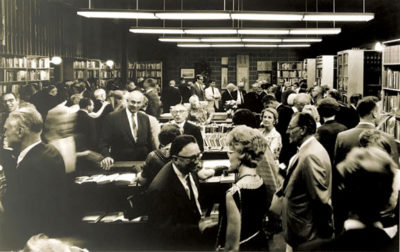All roads lead to the neighborhood, and the Blvd.: part II

DAWSON’S Book Shop opening on Larchmont Blvd. in 1968.
In September 1940, a certain writer made note in her journal about a self-invited dinner guest: “[H]e is an unusually pushing and callous person… It is partly his boundless vitality and partly his thirty years of being an impresario… He is tall and fattish and wears affected clothes… [his] heavy suede shoes had exaggerated square toes. His left eye is larger and higher in his skull and has a mad, mean look to it, like Peter the Great.”
M.F.K. Fisher was not, as you can hear, pleased with her guest — and among her arch observations of his other boorishness, she wrote that after three highballs he talked, constantly and heedlessly, for four hours.
The guest was Merle Armitage (1893-1975), writer, book collector, printer, and book designer (and sometime impresario) who is revered as one of the sparks of the small renaissance of the book arts that erupted in Southern California during the Great Depression. He has been called the “daddy of a sunbaked modernism,” referring to his unfettered and tradition-breaking approach to visual language.
One of his books, “Stravinsky,” is a combination of text and stunningly presented photographs of Igor Stravinsky taken by Armitage’s friend Edward Weston. On the cover begins the text. Armitage’s book is still an adventure to the eye.
In this intimate world of books, everyone knew one another. The printer Ward Ritchie (1905-1996), in his 1989 volume, “Of Bookmen & Printers” (a compilation of Ritchie’s previously published essays), estimates that in 1930s downtown Los Angeles, on just the few blocks of W. Sixth St. from Grand almost to Figueroa, half a million books were for sale.
Los Angeles had a population of 1.2 million then, and there were enough book sellers, collectors, buyers, and designers that certain shops had their specialties, clienteles, and local bibliophiles combing the stacks.
The J.W. Robinson Dept. Store on Seventh St. had a major book section (and Chronicle publisher John Welborne’s mother worked there as a bookseller in the 30s and early 40s).
Certain older collectors of Californiana congregated in Dawson’s Book Shop, opened in 1905, which was then in its third location, at 627 S. Grand Ave. Younger writers and artists, such as Merle Armitage and Paul Landacre, could be found with Jake Zeitlin, who kept a shop for 60 years.
Ward Ritchie also has some choice, dry-as-a-good-martini, words about Armitage. His essay about the designer is titled “Merle Armitage: His Many Loves and Varied Lives,” with this headnote, italicized in the book: Here are some intimate details not generally known of Armitage’s life. He was a colorful impresario, lothario, and maverick designer…. His retinue of wives also reveals his versatility.
“Of Bookmen & Printers” was published by Dawson’s Book Shop, 535 N. Larchmont Blvd.
The N. Larchmont location of Dawson’s was its fifth and final bricks-and-mortar home place, built in 1968 and closed in 2010. (The Dawson family still owns the building.) It was the oldest continuously operating bookstore in the city.
Dawson’s lives on into a third generation. Michael Dawson followed his grandfather, father, and uncle into the rare-book business. It was he who closed shop on Larchmont; he now conducts the business online.
I asked him about the Dawson history of publishing books, which he said began in a small way in the 1920s. In the 1950s, his uncle Glen Dawson began publishing large series, among them the “Early California Travel Series” (50 volumes) and a 17-volume series titled “Los Angeles Miscellany.”
Among the books Michael Dawson offers online is a monograph of the photography of Brett Weston, “designed by his long time friend, Merle Armitage… [who] met Brett Weston in the 1920s when he became close friends with Edward Weston.”
Therein, no doubt, hangs a delicious tale.
By Paula Panich
Category: Entertainment


